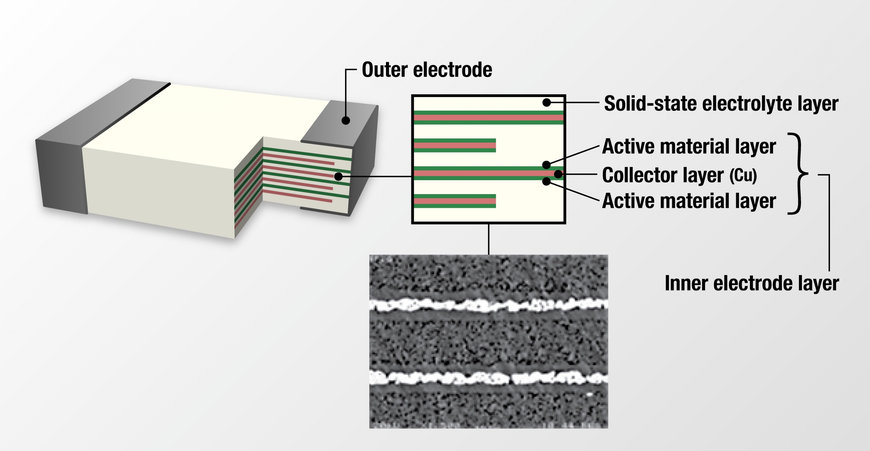electronics-journal.com
26
'22
Written on Modified on
Solid-State Battery Technology Offers Limitless Possibilities to the New IoT Era
The advent of the Internet of Everything (IoE), which intelligently connects people, processes, data and things, requires compact, high performance batteries. For smart devices to become even more prevalent, demand is growing for a safer, more compact rechargeable alternative to conventional lithium-ion (Li-ion) batteries. By Carlos Schlabitz, Product Marketing Manager chez TDK.

Conventional Lithium-Ion Batteries
With their high energy density, Li-ion batteries are commonly used in today’s electronics devices, from laptops, smartphones and wireless earbuds to drones, electric bikes, and electric vehicles. However, these batteries are made with organic solvent electrolytes that are highly flammable and carry a risk of leakage. In the worst-case scenario, battery cell leakage can lead to a fire. The electrolyte is also highly toxic and, if swallowed, can prove fatal. Because of these drawbacks, IoT device makers have been demanding battery manufacturers to develop safer and more reliable solid-state batteries containing a stable electrolyte material.
These next-generation solid-state batteries feature superior safety, high reliability and longer lifespan to Li-ion batteries by using a stable, non-flammable and solid electrolyte material instead of liquid, which eliminates the risk of leakage and fire. TDK was the first manufacturer to introduce an all-ceramic, solid-state surface mount battery, called CeraCharge.
Introducing CeraCharge
CeraCharge is a surface mountable component that offers high energy density, small size, and a high degree of safety. Compared to conventional batteries, rechargeable or otherwise, these robust devices offer a very wide temperature range from -20 °C to +80 °C, making them suitable for both indoor and outdoor use. They are also suitable for vacuum applications. Depending on the system requirements, the number of charge/discharge cycles that they can perform is up to 1000.

Cross Section of CeraCharge Solid-State Battery.
These features were realized thanks to TDK’s knowledge and experience in advanced multilayer ceramic technology, which is used in products such as multilayer ceramic chip (MLCC) capacitors. Here, a relatively high energy density and small volume are combined with the safety and high-volume manufacturing benefits of ceramic MLCCs. Thanks to the surface mount technology, the battery placement is easy. Solid-state CeraCharge batteries can also be processed using reflow soldering techniques, which reduces the production cost of the end product.
Enabling new use cases
The safe, chip-sized solid-state battery is now being used in a wide range of IoT products that were deemed impossible using conventional Li-ion battery technologies. One such application is a 15cm metal thermometer probe from CookPerfect, a Danish company that manufactures a line of cooking thermometers. The product is equipped with five temperature sensors, a BLE (Bluetooth Low Energy) communication module, and TDK’s CeraCharge.

CookPerfect’s Wireless Meat Thermometer (Photo provided by CookPerfect).
When inserted into a joint of meat, the probe measures the internal temperature as it cooks inside the oven. Via a smartphone, the temperature of the meat can be monitored in real-time, enabling meats like Christmas turkeys, to be cooked to perfection.
Martin Kloster, Co-Founder and Managing Director of CookPerfect, says: “When we began designing CookPerfect, battery technology was simply not available that would allow measuring at 5 points, run complex algorithms, and could be built into the unit. But with CeraCharge, we could create the first ‘true wireless’ thermometer.”
Kloster highlights the importance of battery reliability and safety, as these thermometers are inserted directly into food and used in high-heat ovens and grills: “There must never be any chemical leakage. We also needed a high operating temperature range that could withstand usage inside ovens. The fact that CeraCharge has no risk of leakage due to its solid form, is small enough to be installed into a 3.7mm-diameter unit, and can withstand up to 85 ˚C were major deciding factors in choosing it for our product.”
Limitless possibilities
As smart devices, like this cooking thermometer, continue to proliferate, the advent of a full-scale IoT society is on the horizon. CeraCharge is currently being considered for integration into various other types of smart devices, including real-time clocks (RTC) for smart meters, wearables, and smart sensors.
To increase the capacity and the voltage, CeraCharge components can be connected in series and parallel. This opens up a limitless range of possible applications, for example, as the back-up battery for real-time clocks (RTC) or energy storage for Bluetooth LE (BLE) beacon transmission.
In most cases, primary coin cells are used as the back-up battery for RTCs. The major disadvantage of this solution is that users must eventually change it. Replacing the primary cell in the RTC module with a rechargeable battery, such as CeraCharge, overcomes this problem. This is because the RTC generally needs power from the back-up battery for less than one hour at a time - one CeraCharge can back up the RTC function for 1 to 4 weeks without recharging.
Solar-powered BLE beacon technology is emerging as the connectivity solution of choice because of its limited space and low power consumptions requirements. In a typical circuit, the solar cell charges a capacitor, which provides the primary power for the BLE module. When the solar cell is inactive, during the night when it is dark, for instance, the CeraCharge battery is used to store any surplus energy to charge the capacitor, enabling the solar-powered beacon to operate continuously.
For more information, please visit the TDK CeraCharge product page.
www.tdk.com

